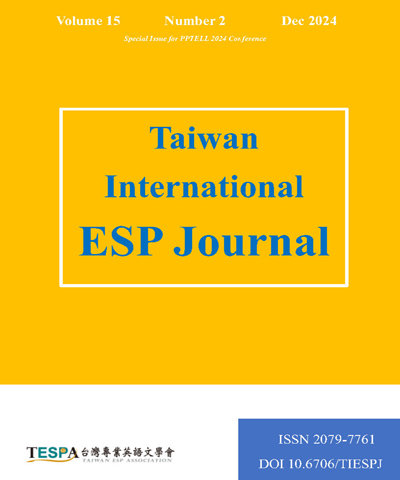
Taiwan International ESP Journal/台灣專業英語文期刊
- OpenAccess
台灣專業英語文學會,正常發行
選擇卷期
- 期刊
- OpenAccess
This paper compares rhetorical structures and citation use between seven Ph. D. students' ("novice") dissertations and seven published writers' ("expert") research articles in the discipline of mechanical engineering in Taiwan. We focused on the introduction sections and compared their move-step structures as well as forms and functions of citations. While the expert writing shows higher citation density, mainly adopts a non-integral format, and emphasizes Move 1 (establishing a territory) and Move 3 (presenting the present study and its purpose), the novice writing predominantly focuses on Move 1. Both groups emphasized the steps of topic generalization, literature review, and niche establishment. It is therefore shown that novice writers mainly cite sources to give credit, but experts use citation to support their claims or ideas. While novices often cite references in isolation, published writers synthesize different sources to establish links among findings. Unsurprisingly, experts know more about mechanical engineering and related topics, and can also frame their own findings in light of contributions made by other researchers. Our findings lead to a clearer understanding of the contrastive genre structure and citation practices between novices and experts, and have pedagogical implications for teaching ESP to novice engineering writers.
- 期刊
- OpenAccess
Research into English for Specific Purposes has long recognized the value of corpus analysis of academic and professional texts. However, few studies have explored religious texts. The Kuan Yin corpus (KYC) plays a significant role in Buddhist literature. This study investigated the keywords and collocates that most frequently occur in the Kuan Yin legends, historical accounts, images, myths and prophesies that make up a specialized KYC comprising 384,598 tokens of running texts in 63 different online texts and books related to the Kuan Yin. The most frequent keywords and collocates were found using WordSmith Tools 6.0. Experts then refined the lists manually. Utilizing the BNC as a reference corpus, 727 of the most frequently occurring word families and 311 collocations from the KYC were ultimately determined. The lists of keywords and collocates defined by this research provide language learners and instructors with direction when learning English related to Buddhism.

